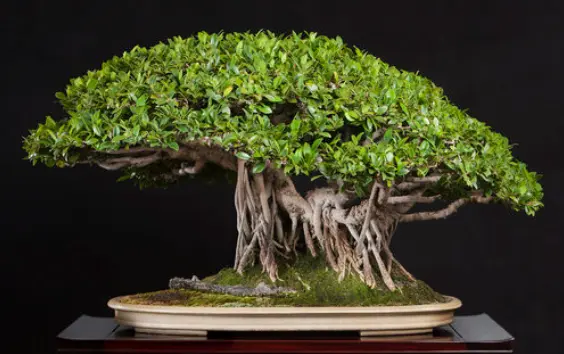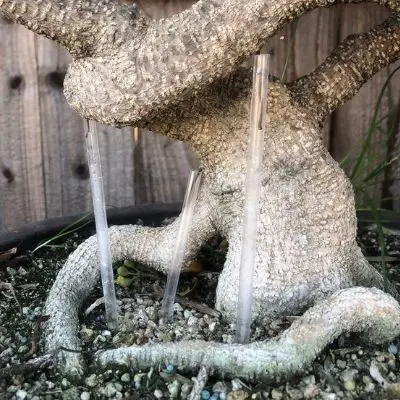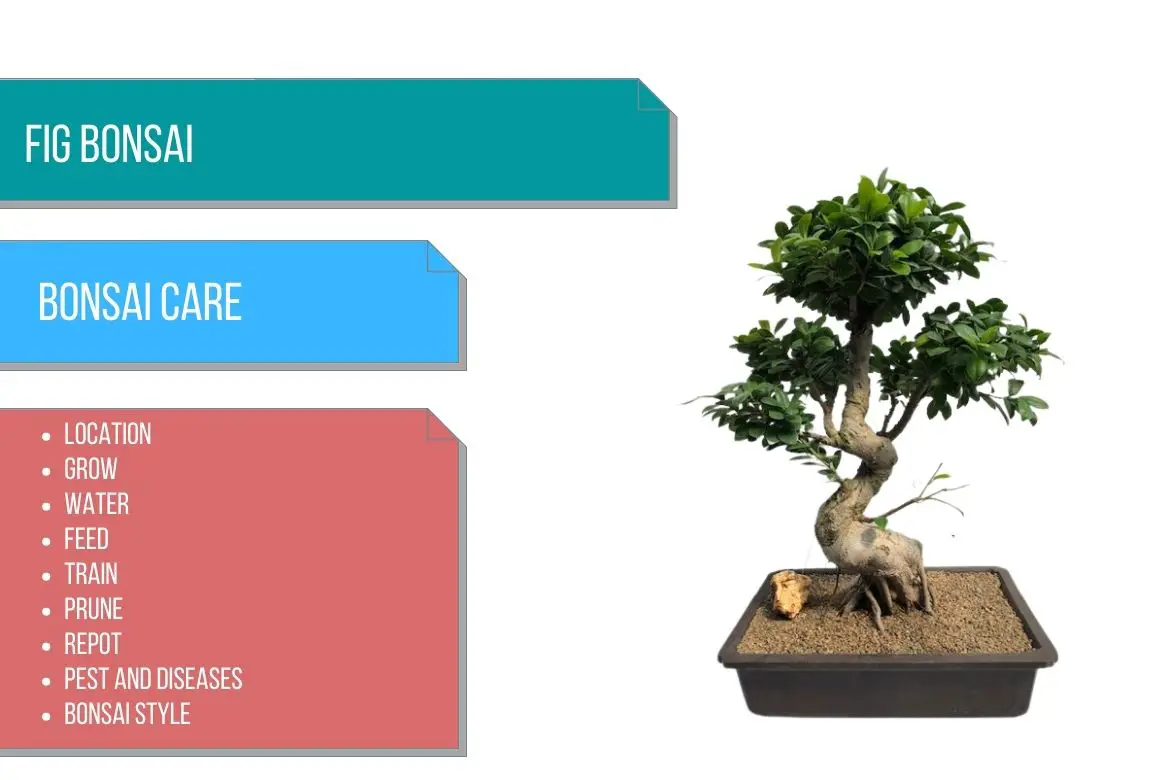
Fig
(Ficus)
Country of Origin : Varies depending on the variety (mostly southern Asia)
Bonsai Styles : Informal upright, cascade, twin trunk, clump, Root over rock, exposed root, aerial root
Zone : 6 – 10
In the world of indoor bonsai, the fig bonsai tree is among the most popular bonsai trees. Fig tree bonsai make and excellent indoor bonsai in temperate countries.
There are many Ficus species that can flourish even in the lower light conditions of an indoor environment.
Also, due to the large variety of tropical and subtropical ficus species available, different leaf shapes, textures, and growth habits are available. This allows bonsai enthusiasts to choose the right ficus variety suitable for their preferred bonsai style and bonsai size.
Ficus bonsai types
As stated earlier, there are many species of ficus tree. Some of the ficus bonsai types are listed below:
* Important : List below (Group-1 and Group-2) are all part of the ficus bonsai tree varieties. However, some varieties of the ficus have slightly different growth habit and hardiness. Hence, for the ease of reading further in the article, we have divided the ficus bonsai types in two groups.
* Click on the name of Ficus species to know about its care instructions
Group-1
- Ficus benjamina (Weeping fig)
- Ficus benjamina ‘Variegata’ (Variegated weeping fig)
- Ficus microcarpa (aka Ficus retusa, Indian laurel, Curtain fig, Malay banyan, Chinese banyan or Glossy-leaved fig)
- Ficus neriifolia (Willow leaf ficus)
Group-2
- Ficus aurea
- Ficus buxifolia (Box leaf fig)
- Ficus pelkan
- Ficus religiosa (Sacred fig)
- Ficus bengalensis (Banyan)
- Ficus rumphii
- Ficus rubiginosa (Port Jackson fig)
- Ficus Burt-davii (Miniature variety of fig)
- Ficus infectoria (Grey variety of fig)
- Ficus virens
- Ficus carica (Edible variety of fig)
- Ficus macrophylla (Small leaf fig variety)
- Ficus pumila (Creeping fig)
- Ficus natalensis (Natal fig)
Most popular ficus varieties for making a fig bonsai tree are Ficus benjamina, Ficus benjamina ‘Variegata’, Ficus retusa, Ficus microcarpa and Ficus neriifolia – Group 1.
However, Ficus aurea , Ficus buxifolia , Ficus pelkan , Ficus religiosa , Ficus bengalensis , Ficus rumphii , Ficus rubignosa , Ficus Burt-davii , Ficus infectoria , Ficus virens , Ficus carica , and Ficus macrophylla – Group 2, are fig bonsai tree varieties which are not easily available in North America and Europe.
The leaves of the bonsai fig are pointed and oval, and the twigs are slender. Aerial roots, heavy and tough roots that grow from the upper branches and trunk, are also naturally produced by fig trees.
These aerial roots naturally graft into the trunk of the fig bonsai tree, resulting in thick bonsai tree.
Southeast Asia’s bonsai enthusiasts use these aerial roots in their bonsai style to create striking images of tropical rain-forests.
Ficus bonsai tree with beautiful aerial roots.
Source : www.bonsai-nbf.org

Best location to keep Ficus Bonsai
Fig bonsai tree does well in humid environment.
Bonsai fig tree from group – 1 (listed above) are tender trees.
Ideal temperature for growing bonsai fig tree from this group is in the range of 68 – 82 °F ( 20 – 28 °C). However, bonsai fig tree of these varieties can also tolerant to temperatures as low as 59 °F (15 °C ) for short term.
It is best to place these bonsai fig tree varieties in direct sunlight, however they are also suited to partial shade conditions indoors.
They can be placed in the sun during the summer season. However, protect it from prolonged hot direct sunlight.
Unlike fig tree bonsai varieties from group – 1, group – 2 fig tree bonsai prefer slightly more light and warmer environment.
Ideal temperature for growing bonsai fig tree from this group is in the range of 66 – 85 °F ( 19 – 30 °C).
Similar to group -1, these varieties can also be placed in the sun during the summer season.
A west, east or south facing window is a good place to keep ficus bonsai tree. Please refer to suitable light conditions for indoor gardening for more ideas.
Propagation Ficus
Fig tree can be propagated by using root cuttings and air layering.
The aerial roots from branches can be taken (along with the below surface roots they have developed) and planted in a container.
When a thicker root from an old branch is used for propagation, a bonsai fig tree that looks mature can be created relatively quickly.
Note : Roots of these thick root cuttings are often wrapped around rocks when they are planted. A “root-over-rock” style is formed by the roots thickening quickly and clasping the rock tightly.
Watering Ficus Bonsai
how to water a fig bonsai ?
Ficus bonsai tree can be watered generously in summer season. However, make sure that bonsai soil is not waterlogged.
Ficus bonsai watering can be reduced in the time of winter. Just make sure that the soil is moist.
All the ficus bonsai trees love humid surroundings. This helps them in growing their aerial roots. Hence, regularly spraying mist on the fig bonsai tree is advisable.
In case you are using a shallow container for fig bonsai tree, you might have to water the plant twice a day in hot summers.
Wiring Ficus Bonsai
Wiring of ficus bonsai tree can be done at any time of the year. In few months the branches of fig tree will take the desired shape when wired.
Make sure to remove the wires as soon as the desired space is achieved.
It is advisable to wire the branches of fig trees while they are flexible.
Wire can also be used to direct aerial roots.
Aerial roots can also be directed by inserting them in wide drinking straws. This will help the roots to reach the bonsai soil fast.
The straws also capture some moisture which is supplied to the roots. This also helps in growth of the aerial roots.
Source : www.bonsainut.com

Pruning Ficus Bonsai
When to prune ficus bonsai tree?
In an indoor environment, bonsai fig tree does not typically require hard pruning. However, you can perform hard pruning at the time of repotting. It responds well to hard pruning.
Starting pruning is spring is a good idea.
Prune back shoots to two or three leaves after they have grown six to eight leaves.
Once a trunk is established, figs branch rapidly as a result of their strong growth habit. This is good for branch development, however this may also cause the branches to thicken too much, making them appear disproportionate.
When branches thicken too much, prune them down to a thinner side branch every few years to maintain a smooth taper.
You can also opt for partial or total defoliation of the fig bonsai tree in early summer.
At the time of pruning, the fig tree bonsai will exude a white milky sap. This sap will self seal. Hence there is no need to apply cut paste to the wound.
Additionally, you can also perform pruning in winter when the flow of the sap is slow.
Pinching Ficus Bonsai
During the growing season, pinch out the growing tips to keep the tree in shape.
Repotting Ficus Bonsai
When to repot ficus bonsai tree?
Repotting of ficus bonsai tree can be done in late winter or spring. However, repotting can also be done at any time of the year if proper care of the bonsai tree is taken.
You can repot the tree once every two to three years.
Fig trees handle root pruning with no issues. However, after pruning the roots, keep the pot warm in order to promote rapid regrowth of roots.
After repotting, do not water straight away, or else all the leaves will drop.
Best soil for ficus bonsai :
You can use the standard soil mix.
OR
You can use 40% grit and 60% organic matter.
OR
You can also use a bonsai soil mix of sharp sand, loam and peat in 1:1:1 ratio.
Must Read: Bonsai Soil Recipes
Feeding Ficus Bonsai
Ficus bonsai fertilizer
Fertilizer can be applied to Fig tree bonsai throughout the growing season.
Throughout the growing season, apply a general fertilizer every two to three weeks. In the winter, feeding should be reduced to once a month.
Alternatively, you can keep the fertilizer application frequency constant but reduce the fertilizer strength to half during winter.
Diseases and pest of Ficus Bonsai
All the species of the ficus bonsai tree are vulnerable to scale insects. These insects infect the undersides of the leaves and stems. This can be treated by applying a weak dose of systemic insecticide.
Ficus bonsai tree care
Ficus bonsai tree varieties of group – 1 (mentioned above in the article) are relatively more easy to care for when compared to fig varieties of group – 2.
Fig bonsai trees don’t like drafts and sudden temperature changes.
The older leaves will turn yellow when the fig tree bonsai is moved around or exposed to drafts or dry air. To avoid this, once a suitable location has been finalized, do not move the bonsai tree.
It should also be rotated once a week so that it receives equal amounts of light from all sides.
Sudden changes in the environment will cause them to loose their leaves. For example, when shifting the location or bringing them from nursery to home or even when they are “over” or “under” watered. However, they regrow their leaves pretty quickly.
Fig tree bonsai releases a large amount of milky sap when it is pruned during its rapid growth phase. It may be difficult to remove the stain after the sap flows on the branch and dries.
In order to avoid this staining, you can prune the fig bonsai tree in the winter. And to quickly seal the wound, you can apply some modeling clay or apply a red hot metal (eg. screwdriver) briefly to the wound.
Plant your fig in a larger bonsai container and keep it in a warm, bright and humid location if you want it to grow into a large bonsai specimen.
In 4-5 years, the fig tree bonsai will have large enough aerial roots which will self graft into the main trunk. Now is the time to move the fig bonsai tree to an even bigger bonsai pot.
When growing and well watered, the bark of most ficus varieties swell rapidly. This can lead to the trunk biting into the wire resulting in scaring of the trunk. Regularly check all wires, and if they appear too tight, remove them and reapply later.
What to look for when buying Ficus Bonsai
As mentioned earlier, propagation of the fig tree is done by root cuttings. Hence while buying a fig bonsai tree, make sure that the base of the original cutting is below the soil.
As new branches are slow to grow in a indoor setting, choose a bonsai tree that already has a good branch structure.
Commercial fig bonsai are not given much attention when it comes to the arrangement of their roots. Often, it is the case that there are too many roots in a messy clump.
In case you do not want to invest 2-3 years in pruning thinning and shaping of these roots, opt for a simpler fig bonsai specimen.


1 comment
Simply wanna admit that this is handy, Thanks for taking your time to write this.